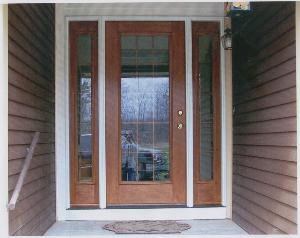exterior door selection

New exterior doors often fit and insulate better than older types. If you have older doors in your home, replacing them might be a good investment, resulting in lower heating and cooling costs. If you're building a new home, you should consider buying the most energy-efficient doors possible.
When selecting doors for energy efficiency, it's important to first consider their energy performance ratings in relation to your climate and home's design. This will help narrow your selection.
Types of doors
One common type of exterior door has a steel skin with a polyurethane foam insulation core. It usually includes a magnetic strip (similar to a refrigerator door magnetic seal) as weatherstripping. If installed correctly and if the door is not bent, this type of door needs no further weatherstripping.
The R-values of most steel and fiberglass-clad entry doors range from R-5 to R-6 (not including the effects of a window.) For example: A 1-1/2 inch (3.81 cm) thick door without a window offers more than five times the insulating value of a solid wood door of the same size.
Glass or "patio" doors, especially sliding glass doors, lose heat much faster than other types of doors because glass is a very poor insulator. Most modern glass doors with metal frames have a thermal break, which is a plastic insulator between inner and outer parts of the frame. Models with several layers of glass, low-emissivity coatings, and/or low-conductivity gases between the glass panes are a good investment, especially in extreme climates. Over the long run, the additional cost is paid back many times over in energy savings. When buying or replacing patio doors, keep in mind that swinging doors offer a much tighter seal than sliding types.
With a sliding glass door, it's impossible to stop all the air leakage around the with weatherstripping and still be able to use the door. Also, after years of use, the weatherstripping wears down so air leakage increases as the door ages. If the manufacturer has made it possible to do so, you can replace worn weatherstripping on sliding glass doors.
See also external door installation.
